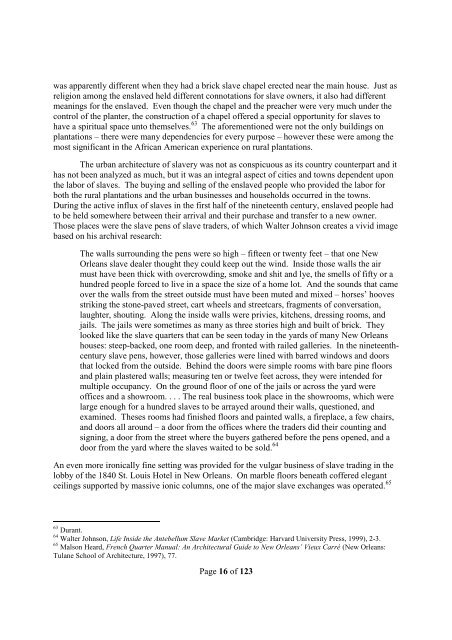The African American Experience in Louisiana
The_African_American_Experience_in_Louisiana
The_African_American_Experience_in_Louisiana
- No tags were found...
Create successful ePaper yourself
Turn your PDF publications into a flip-book with our unique Google optimized e-Paper software.
was apparently different when they had a brick slave chapel erected near the ma<strong>in</strong> house. Just as<br />
religion among the enslaved held different connotations for slave owners, it also had different<br />
mean<strong>in</strong>gs for the enslaved. Even though the chapel and the preacher were very much under the<br />
control of the planter, the construction of a chapel offered a special opportunity for slaves to<br />
have a spiritual space unto themselves. 63 <strong>The</strong> aforementioned were not the only build<strong>in</strong>gs on<br />
plantations – there were many dependencies for every purpose – however these were among the<br />
most significant <strong>in</strong> the <strong>African</strong> <strong>American</strong> experience on rural plantations.<br />
<strong>The</strong> urban architecture of slavery was not as conspicuous as its country counterpart and it<br />
has not been analyzed as much, but it was an <strong>in</strong>tegral aspect of cities and towns dependent upon<br />
the labor of slaves. <strong>The</strong> buy<strong>in</strong>g and sell<strong>in</strong>g of the enslaved people who provided the labor for<br />
both the rural plantations and the urban bus<strong>in</strong>esses and households occurred <strong>in</strong> the towns.<br />
Dur<strong>in</strong>g the active <strong>in</strong>flux of slaves <strong>in</strong> the first half of the n<strong>in</strong>eteenth century, enslaved people had<br />
to be held somewhere between their arrival and their purchase and transfer to a new owner.<br />
Those places were the slave pens of slave traders, of which Walter Johnson creates a vivid image<br />
based on his archival research:<br />
<strong>The</strong> walls surround<strong>in</strong>g the pens were so high – fifteen or twenty feet – that one New<br />
Orleans slave dealer thought they could keep out the w<strong>in</strong>d. Inside those walls the air<br />
must have been thick with overcrowd<strong>in</strong>g, smoke and shit and lye, the smells of fifty or a<br />
hundred people forced to live <strong>in</strong> a space the size of a home lot. And the sounds that came<br />
over the walls from the street outside must have been muted and mixed – horses’ hooves<br />
strik<strong>in</strong>g the stone-paved street, cart wheels and streetcars, fragments of conversation,<br />
laughter, shout<strong>in</strong>g. Along the <strong>in</strong>side walls were privies, kitchens, dress<strong>in</strong>g rooms, and<br />
jails. <strong>The</strong> jails were sometimes as many as three stories high and built of brick. <strong>The</strong>y<br />
looked like the slave quarters that can be seen today <strong>in</strong> the yards of many New Orleans<br />
houses: steep-backed, one room deep, and fronted with railed galleries. In the n<strong>in</strong>eteenthcentury<br />
slave pens, however, those galleries were l<strong>in</strong>ed with barred w<strong>in</strong>dows and doors<br />
that locked from the outside. Beh<strong>in</strong>d the doors were simple rooms with bare p<strong>in</strong>e floors<br />
and pla<strong>in</strong> plastered walls; measur<strong>in</strong>g ten or twelve feet across, they were <strong>in</strong>tended for<br />
multiple occupancy. On the ground floor of one of the jails or across the yard were<br />
offices and a showroom. . . . <strong>The</strong> real bus<strong>in</strong>ess took place <strong>in</strong> the showrooms, which were<br />
large enough for a hundred slaves to be arrayed around their walls, questioned, and<br />
exam<strong>in</strong>ed. <strong>The</strong>ses rooms had f<strong>in</strong>ished floors and pa<strong>in</strong>ted walls, a fireplace, a few chairs,<br />
and doors all around – a door from the offices where the traders did their count<strong>in</strong>g and<br />
sign<strong>in</strong>g, a door from the street where the buyers gathered before the pens opened, and a<br />
door from the yard where the slaves waited to be sold. 64<br />
An even more ironically f<strong>in</strong>e sett<strong>in</strong>g was provided for the vulgar bus<strong>in</strong>ess of slave trad<strong>in</strong>g <strong>in</strong> the<br />
lobby of the 1840 St. Louis Hotel <strong>in</strong> New Orleans. On marble floors beneath coffered elegant<br />
ceil<strong>in</strong>gs supported by massive ionic columns, one of the major slave exchanges was operated. 65<br />
63 Durant.<br />
64 Walter Johnson, Life Inside the Antebellum Slave Market (Cambridge: Harvard University Press, 1999), 2-3.<br />
65 Malson Heard, French Quarter Manual: An Architectural Guide to New Orleans’ Vieux Carré (New Orleans:<br />
Tulane School of Architecture, 1997), 77.<br />
Page 16 of 123


